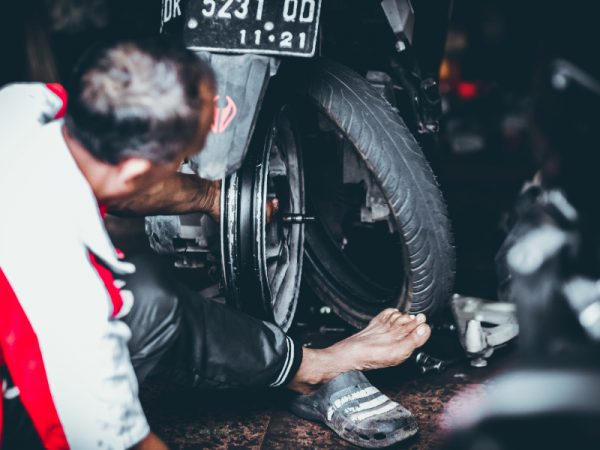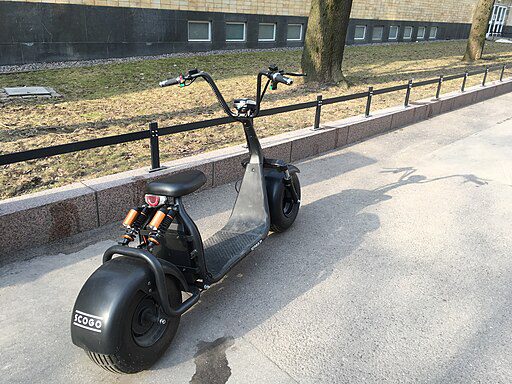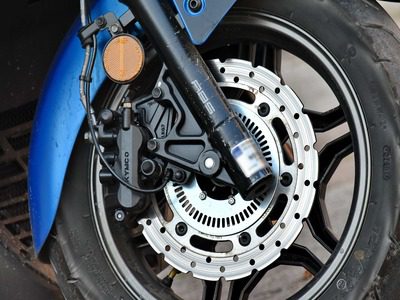Whether we’re zipping around the neighborhood on our weekend rides or relying on our scooters for daily commuting, we all know just how much fun and convenience these two-wheelers bring to our lives.
But, as with anything that gets regular use, keeping up with scooter maintenance is a must. Regular check-ups and maintenance tips for your scooter’s vital parts, such as the new wheel, are essential. It’s not just about prolonging the life of our beloved scooters; it’s also about ensuring our safety while we’re out and about.
From understanding the ins and outs of our scooter’s anatomy to checking tires, brakes, and batteries, we’re here to guide you through the essentials of scooter maintenance. It’s our goal at FamilyHype to help you troubleshoot common issues and know when it’s time to seek professional help.
We’ll also dive into key safety measures to keep the fun rolling without compromising our well-being. We encourage you to share your own experiences and opinions about scooter care with us on our blog or social media, and would love to hear from you!
Furthermore, we’ll explain the importance of things like scooter helmets, reflective gear, and even how to properly park your scooter to avoid fines.
So, let’s roll up our sleeves and dive into the world of scooter care together!
Key Takeaways
- Regular scooter maintenance is important for prolonging the life of the scooter and ensuring safety.
- Routine maintenance can prevent unexpected breakdowns and maximize the scooter’s lifespan.
- Understanding the different components of a scooter’s anatomy is essential for performing maintenance and repairs.
- Importance of safety measures for scooter enthusiasts.
Importance Of Regular Maintenance
You can’t underestimate the value of regular scooter maintenance – it’s not just about keeping the good times rolling, but also ensuring every ride’s as safe as it can be!
Let’s not forget either that maintenance cost is often less than the cost of repairing a neglected scooter. Scooter repair can cost a lot – especially if you haven’t taken care of it at all. Plus, following a routine schedule can help prevent unexpected breakdowns, maximizing the vehicle’s lifespan.

We can’t stress enough that regular upkeep is a crucial part of serving others. When we adhere to a regular maintenance schedule, which includes maintenance tips for electric scooter maintenance, checking scooter battery health, monitoring tire pressure, maintaining your scooter, adjusting valve clearance, taking care of moving parts, and addressing scooter repair when needed, we’re not just taking care of ourselves, we’re ensuring the safety of others on the road as well.
Now that we’ve covered the importance of routine maintenance, let’s delve deeper into the exciting world of your scooter’s different components and how they work together.
Understanding The Anatomy
Diving deeper into the inner workings of your two-wheeled ride, it’s essential to grasp the different components that ensure it runs smoothly and efficiently. Understanding your scooter’s anatomy can empower you to perform routine maintenance, carry out minor repairs, and even embark on customization projects with confidence. It is important that you know all the components of your vehicle and that you regularly check it to keep it in good condition.
Key parts include the engine, transmission, suspension, brakes, and tires. Accessory installation, like adding mirrors or storage compartments, can also play a part in your scooter’s overall functionality. Familiarity with these elements means you’re not just a rider, but a responsible owner who values safety and performance.

Remember, knowing your scooter inside out is just the first part of the maintenance journey. Next, we’ll delve into the importance of routine checks and maintaining a clean scooter for optimal performance.
Routine Checks
Ensuring that your two-wheeler is always in tip-top shape isn’t just about understanding its anatomy, but also about conducting regular checks and honoring the value of cleanliness. We believe in the power of a well-maintained scooter—something that brings joy, safety, and a sense of pride to every ride.
A clean scooter is a happy scooter. Here are our top tips for keeping yours looking and running its best:
- Choose high-quality cleaning products designed specifically for scooters. They’ll help protect the finish and keep things shiny.
- Develop a routine for checking and cleaning different parts of the scooter. This could be weekly, bi-weekly, or monthly, depending on your usage.
- Consider your storage practices. Keeping your scooter in a dry, secure location can prevent rust and other damage.
Before you do anything to your motor, consult the owner’s manual first. Every model has different special features so it is important that you understand that. Regularly maintain your scooter to keep it running smoothly. As we shift gears, let’s dive deeper into one aspect of maintenance that directly affects your scooter’s performance—tire care.
Tires
Caring for your two-wheeler’s tires isn’t just about keeping them inflated—it’s about understanding the importance of regular checks, recognizing the signs of wear and tear, and knowing when it’s time for a replacement.

We’ve got some insightful tips for you! Firstly, tire pressure adjustment is crucial. A well-inflated tire ensures a smoother ride and increases the vehicle’s lifespan.
Next, keep an eye out for any signs of damage. Regular checks can help in puncture prevention and early detection of any issues. If you spot uneven wear, it might be time to replace your tires.
Remember, proactive tire maintenance is a great way to ensure the safety and longevity of your scooter. It might seem tedious, but it’s worth it. Last but not least, try to wash it every now and then, as there can be dirt buildup on your cables and tires.
Now, let’s take a look at another critical aspect: regularly checking up on the brake system.
Brake System
It’s absolutely vital that you don’t overlook your two-wheeler’s brake system, as it directly impacts your riding experience and overall vehicle performance. Regular brake system maintenance should be part of your routine care.
This includes brake fluid replacement and brake pad inspection. Brake fluid replacement is crucial because it helps keep up your motor’s braking power. Over time, brake fluid can become contaminated and lose its effectiveness, which can lead to brake failure. Similarly, brake pad inspection is a must. Worn-out brake pads can reduce your scooter’s stopping power and eventually damage the brake discs.
Another thing to check is the brake linings. These are important to maintain in your motorcycle as it is one of the most crucial components there is. Check cracks, check brakes, check valve stems, and check throttle cables in the motor are a few of the initial scooter maintenance tips we have.
By diligently taking care of these, we can ensure a safe and enjoyable ride every time.
Now, let’s delve into the heart of your scooter: engine maintenance.
Engine
Let’s dive into the heart of scooter maintenance, the engine. Changing engine oil and spark plug maintenance are two critical aspects that can significantly impact the performance and longevity of your scooter.
We’re here to guide you through these processes, ensuring that your vehicle runs smoothly and safely for many rides to come.
Changing Engine Oil
Regularly changing the engine oil isn’t just about keeping your ride smooth – it’s a critical part of ensuring your safety on the road. It’s a simple process that can significantly improve your scooter’s performance and longevity. Here’s how you can get it done:
- Oil Selection: Opt for a high-quality oil that’s suitable for your scooter’s engine type. This ensures optimum performance and protects the engine from wear and tear.
- Drain Old Oil: Warm up your scooter briefly before draining the old oil. This helps in removing the oil completely.
- Filter Replacement: Don’t forget to change the oil filter as well. A clean filter ensures that the new oil doesn’t get contaminated with old residues.
The easiest part of maintenance is when you check the oil level. Changing it every 1000 miles for most scooters is a good idea. It is a good way to keep your engine alive for as long as possible. Next, let’s delve into the importance and process of spark plug maintenance.
Spark Plug
Having walked through the process of changing engine oil, let’s shift our attention to another crucial component of scooter maintenance: the spark plug. This small part has a significant role in keeping your scooter running smoothly and efficiently. The lifespan of a plug varies, influenced by the type and quality of the spark plug used.
There are different spark types, each with its own strengths and suitable for certain engine types. It’s crucial to regularly examine your spark plug for signs of wear and tear and replace it when necessary. Remember, a well-maintained spark plug can dramatically enhance the performance of your scooter.
Now, let’s switch gears and delve into another essential aspect of scooter upkeep: ensuring a healthy battery life.
Battery
You’ll feel a rush of joy every time your scooter kicks into gear with ease, thanks to proper battery care. A well-maintained battery not only ensures a smooth ride but also extends the battery lifespan, keeping you on the road longer.
Here are four key tips to follow:
- Regularly inspect your battery for any signs of damage or corrosion.
- Keep the battery clean and dry, as moisture can lead to problems.
- Use appropriate charging techniques, ensuring not to overcharge or undercharge.
- Ensure the battery is securely mounted to prevent damage from vibrations.
Remember, serving others includes ensuring safety and reliability in our shared passion for scooting.
As we transition into the subsequent section, let’s delve into troubleshooting common issues for a hassle-free ride.
Troubleshooting Common Issues
Sometimes, despite your best intentions, things can go wrong and it’s then that you’ll need to put on your detective hat to uncover and fix the issue.
Scooter customization can be a thrilling venture, but it can also present its own set of challenges. Performance enhancement can cause strain on parts that may not be designed to handle the extra pressure.
A scooter that isn’t starting, stalling, or has a fluctuating power supply can be frustrating. Checking the spark plugs, air filter, and fuel system can often reveal the problem.
We’re here to guide you through these hiccups, ensuring your ride remains smooth and safe. And remember: knowing when to call in the pros is equally as important in maintaining the health and longevity of your scooter.
When To Seek Professional Help
While we’ve discussed how to troubleshoot common problems with your scooter, there will be times when these DIY fixes won’t cut it. That’s when professional assistance becomes essential.
Mechanic consultations are invaluable in these instances. They possess the knowledge and expertise to diagnose and fix problems that may be beyond our understanding or capability. It’s important to remember, though, that repair costs can vary, so don’t be shy to ask for estimates. An honest mechanic will be transparent about these costs.
Remember, it’s not just about fixing the issues; it’s about ensuring the continued enjoyment and safety of your scooter. Speaking of safety, let’s transition to our next point of discussion. We’re going to delve into the importance of safety measures for scooter enthusiasts like us.
Safety Measures
It’s crucial, isn’t it, to ensure we’re not just having a blast on our two-wheelers, but also taking all necessary precautions to avoid any mishaps?
Safety measures are not just about scooter maintenance; it’s also about protecting ourselves.
Let’s talk about Helmet Importance and Protective Gear.

Wearing a helmet is non-negotiable. It safeguards our head from injuries, reducing the risk of concussion or worse. It’s not just a good idea; it’s a lifesaver.
But the helmet isn’t our only line of defense. Protective gear, like knee and elbow pads, can shield us from scrapes and fractures. Gloves can prevent hand injuries and improve grip.
Safety doesn’t have to be boring. With plenty of stylish options available, we can look cool while staying safe.
So, let’s gear up and keep the fun rolling!
Conclusion
We’ve covered a lot, haven’t we? From essential scooter maintenance to the importance of safety, FamilyHype has provided you with an abundance of information.
Let’s not forget, caring for our scooters is more than just fun: it’s a responsibility. Regular inspections, preventative maintenance, and knowing when to seek professional help can keep you and your family safe.
Share your scooter experiences and opinions with us on FamilyHype; together, we can create a community that values safety and reliable scooters.
Brands like Segway, Razor, and Micro have revolutionized the scooter experience, providing a sense of adventure and excitement. So let’s keep rolling, but let’s do it responsibly.
An ounce of prevention is worth a pound of cure. Happy scooting, folks!
Frequently Asked Questions (FAQs)
How Do You Do Upkeep On Scooters?
A few maintenance tips that are important in taking care of a scooter are checking the tire pressure, tread depth, condition of motor brake pads, brake discs, battery, lights, and engine oil. Check it regularly, or a minimum of at least every month or every 250 miles.
How Often Should I Change The Oil?
It is a general rule that your engine oil must be changed every 3,000 to 5,000 kilometers. Of course, it depends on your oil type, so check with your manufacturer what kind of petrol it requires.
Are They Hard To Take Care Of?
A scooter is definitely easier to maintain than a car. It doesn’t take up a lot of your time as long as you regularly check up on how it is and clean it as consistently as you can. It is easier to do upkeep on it as it has fewer components and you’ll only need a few tools to sustain it.
Do They Require Less Upkeep Than Motorcycles?
Motors tend to be harder to take care of than scooters because of their size. It can be more costly since they have more expensive parts. They do tend to last longer and are cheaper to replace compared to a motor, and they require less upkeep.
How Can I Make Them Last Longer?
Aside from keeping up with the maintenance it requires, some key components that you should take care of are its battery, oil, brakes, CVT drive belt, and the other elements we’ve listed on this page. So that it stays efficient, you must regularly take care of it.
How Long Can They Last?
It depends on the make and model but usually the more expensive the model is, the better the quality of its parts.
How Long Can They Run Without Oil?
Although engines can work without oil, you only have less than 30 minutes of running power left – usually quicker than that. But remember: this can be quite damaging, so it is recommended that you don’t use it without oil.
What Happens If You Don’t Change The Oil?
When your oil has not been changed for a long time, it can turn into a gel or solidify, turning into sludge. This is not good as it can damage the engine and cause it to overheat. The vehicle’s performance can suffer and lead to eventual destruction.
What Causes One To Go Slow?
The most common cause is that it has a faulty battery pack or the battery is already worn out. Sometimes it can be your motor’s problem, but that is less common. The solution would be to replace your battery.
How Do I Keep My Battery Healthy?
Keep your battery charged up to 90% and make sure that you plug it in when it’s at 10%. Most e-scooters are built for 500-1000 charge cycles. So it is recommended that you don’t let the battery die and don’t let it overcharge so that you can extend its overall lifespan.
DISCLAIMER (IMPORTANT): This information (including all text, images, audio, or other formats on FamilyHype.com) is not intended to be a substitute for informed professional advice, diagnosis, endorsement or treatment. You should not take any action or avoid taking action without consulting a qualified professional. Always seek the advice of your physician or other qualified health provider with any questions about medical conditions. Do not disregard professional medical advice or delay seeking advice or treatment because of something you have read here a FamilyHype.com.